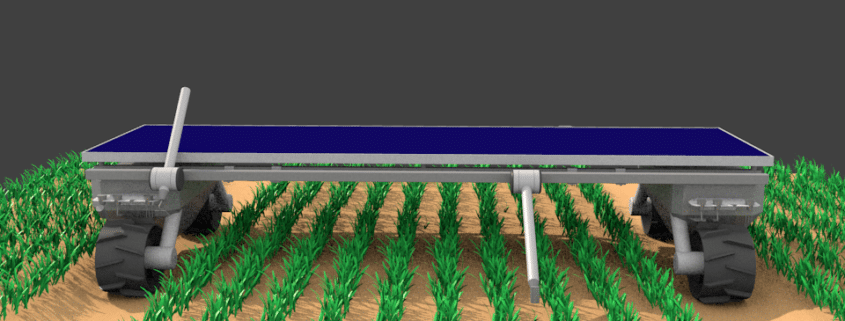
AI field robots for resource efficient agriculture
Background: Obstacles of agriculture
For decades, agriculture has been in a dilemma. On the one hand, efficiency in food production must be increased because of the ever-growing world population, while at the same time environmentally friendly methods with fewer pesticides and fertilizers are demanded. But low-additive organic production is generally more labor-intensive and thus more costly.
Conventional agriculture uses high levels of pesticides, which have been linked to observed insect die-offs, which in turn can throw the ecosystem out of balance.1 In addition, the massive use of fertilizers causes nutrients to enter surrounding standing and flowing waters, resulting in eutrophication (massive growth of algae and bacteria), which leads to oxygen-free zones (so-called “dead zones”) that massively restrict habitat and water use.1 More efficient and targeted methods of controlling unwanted weeds and fertilizing crops in agriculture are therefore urgently needed.
One solution here is offered by specialized robotics, linked to an innovative AI system. In this way, fertilizers and pesticides can be added in targeted quantities as needed. The BE Group has already founded a company for automated AI robotics in vertical farming in this field and sold it again after successful scaling and placement on the market. Now we turn to the open field, where 99% of all food is produced.
Innovation: AI field robots for efficiency
For several years, companies have been working on various large and small field robots for commercial and organic farming. The tractors and implements driven by humans are to be replaced by automated robots, saving time and money and increasing precision and efficiency. Now some of them are already available on the market. These are mostly larger machines that can harrow, sow and/or hoe. Most of the robots plow the soil and regularly loosen it and put the seeds in the ground. Camera systems based on artificial intelligence (AI) in image recognition can also perform various and highly precise actions. For example, the AI camera system recognizes the desired crop in all its growth stages and removes weeds around it mechanically by hoeing, or chemically by precisely applying pesticides or herbicides. This can save large amounts of ultimately toxic substances.
Most of the robots are electrically powered, with many carrying a photovoltaic panel. With sufficient sunlight, the robot can thus work all day and all night until the next morning.
Potential: The future of precision
The use of robotics can make farming much more resource-efficient. However, large, heavy robots, similar to conventional agricultural machinery, are so heavy that they contribute to soil compaction – and constantly so, as they travel over fields much more frequently than tractors do for sowing, fertilizing and harvesting. In addition, large robots are costly and thus out of financial reach, especially for smaller farms. BE Solutions therefore sees particular potential in the use of many small robots instead. Several lightweight robots can cover the same area as one large one, without its disadvantages. In addition, small robot units can be scaled flexibly (“numbering up”) and thus better adapted to the size and needs of each customer.
Robotics also still holds a lot of potential in sensor technology. For example, they can determine the soil’s moisture level as they drive through fields, making water use more efficient as well. Plant predators can be detected and combated in a targeted manner, and the optical detection of growth phases could also be used to determine the optimum harvest time. Here, the longer the robots work and collect data, the more efficient and accurate the results obtained from the data will be – and the more sustainable farmers can act.
In this way, field robots can make land use sustainable and conserve resources, not only avoiding yield losses but rather increasing yields through precise and individual plant care.
This could also interest you: From plastics to protein – insects.
References:
2 https://www.bund.net/themen/landwirtschaft/folgen-fuer-die-umwelt/
3 https://www.wwf.de/themen-projekte/fluesse-seen/wasserverbrauch/wasser-verschwendung



